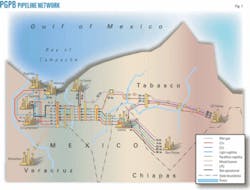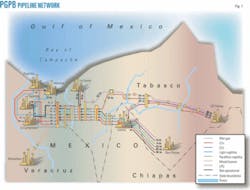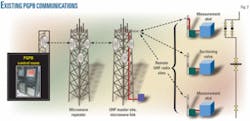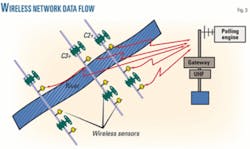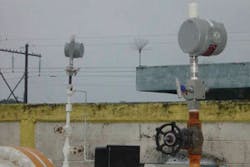A new pipeline wireless sensor network system used by Pemex Gas y Petroquimica Basica is improving operational efficiency and safety and should help reduce theft and sabotage. Since its installation in January 2007, the system has operated without failure.
PGPB is the division of the Mexican national oil and gas company that transports gases and basic petrochemicals across the country. PGPB manages its network of pipelines from a control center in Mexico City and has a large portion of the pipeline integrated into its supervisory control and data acquisition system.
PGPB, however, has never before acquired information about the operational conditions of its pipelines transporting basic petrochemicals, propane, ethane, and methane among its processing centers, a network of roughly 600 km.
This article documents PGPB’s search for sensor technology that would monitor and properly manage its pipeline network (Fig. 1) and provide rapid access to remote data such as gas pressures from sectioning and transport valves across the network. PGPB wanted operators in the control room, processing centers, and process final destinations to be able to provide operational alarms and monitor the status and operating conditions of the pipeline as well as monitor real-time pressure trends with a high degree of confidence.
PGPB also wanted the system to detect anomalies caused by sabotage or theft, which have proven highly dangerous. Finally, the new technology was to provide a balance system for transport schedules (sent and received) as agreed between the processing centers.
PEMEX evaluated both wired and wireless solutions for this project, concluding that a wireless solution provided a better business case based on the following evaluation criteria:
- Wireless solutions provided a total saving in installation costs that exceeded 70% of wired solutions
- Maintenance costs associated with annual battery replacement were very small comparable to maintenance costs of traditional solutions.
- Project execution time was the clear edge, with budget spending restraints and a project execution time not to exceed 2 months.
Problems
PGPB faced problems installing any automation system.
- Power sources such as solar panels or battery banks, even copper cables and instruments were frequently stolen or damaged.
- PGPB’s SCADA system operates on a UHF-microwave backbone that supports limited communication protocols such as BSAP and Pemex Modbus. Any new wireless monitoring technology, however, would have to be integrated with this system.
A new generation of wireless sensors, packaged in a low-profile explosion proof enclosure with the full assembly painted the same color of the pipeline, helped address these problems. The equipment is completely autonomous, operating on an internal battery pack designed to last 1 year with the wireless sensor transmitting every 5 sec.
This self-sufficient wireless design eliminated the need for the type of wiring that was typically stolen.
The wireless sensors transmit data to a gateway a few miles away. The sensors and gateway are both configured to communicate with Pemex Modbus protocol, using the existing UHF backbone and providing transparency to the SCADA system.
Installing a system in such a large geographic area, extending across three states in southeast Mexico is a major logistical challenge, making ease of configuration and installation important.
System architecture
A key element of any SCADA system is communications network reliability. Any delayed or inaccurate responses can lead to an inaccurate understanding of the pipeline’s operating state, potentially compromising safety. PGPB used a well-designed SCADA communications backbone (Fig. 2), consisting of point-to-multipoint master UHF towers installed alongside the pipeline network, with each master site covering pipeline in a diameter of about 80-100 km.
A point-to-point microwave network links each of these UHF towers to the main control room in Mexico City. This network gives PGPB a secure and redundant link with independent communications channels for each master site, improving the overall polling cycle and optimizing the performance of the whole communications network.
The wireless sensor system architecture (Fig. 3) had to work transparently with this communication backbone. Its main components are:
- Multiple numbers of wireless sensors at each pipeline monitoring station creating a mesh network reporting to one wireless gateway data concentrator.
- A point-to-multipoint transponder in the center of this mesh receiving messages from all wireless sensors registered with the corresponding gateway.
- Using gateway data to map from wireless sensor messages into relevant registers according to their ID.
- Serially connecting the gateway to the UHF radio network.
- The SCADA polling engine getting data from the gateway using its own UHF-microwave communications backbone.
Fig. 4 shows the final installed system.
Wireless sensors
System operation begins with collection of data. Wireless sensors installed on the pipeline acquire measurement information such as pressure and convert these data into electrical signals suited for transmission. The wireless sensors transmit once every 30 sec. This frequency used a 1-year evaluation of the SCADA system polling cycle to provide a 1-year battery pack life for the data gateway (Fig. 5).
The gateways are then scanned once per minute by an associated UHF base station, with data sent at that time. When the base station receives the data, the point-to-point microwave network relays it to the main control room in Mexico City.
In addition to receiving remote data, the network can also direct commands to a particular remote station. This will prove particularly useful in the second phase of this project, planned for later in 2007 and scheduled to cover control of solenoid valves for security sectioning in case of leaks or anomalies that have caused HSE incidents in the past.
Network management
Besides operating the pipeline network, the system provides diagnostic information to facilitate operations and guarantee data integrity. Each transmitted message from the wireless sensor includes a battery voltage reflecting the real voltage of the battery pack providing power to the wireless sensor.
This register will provide PGPB operations the advantage of planning maintenance trips to sites with low-battery levels, pursuing maintenance issues proactively rather than waiting for the sensor to stop reporting.
Diagnostic data allow PGPB close monitoring and configuration of its network-including sensor status at the remote stations-without the need to visit sites personally to make minor changes. With more than 600 km of pipeline to manage, frequent site visits would be time consuming and cost prohibitive for HSE purposes.
The authors
Sami Suheil ([email protected]) is director of systems and integration and project manager for the PEMEX Intercentros project at vMonitor in Houston. Suheil has over 14 years’ experience working in automation, telemetry, and telecommunications. He holds a degree in electrical engineering from the University of Houston (1993). Suheil is a member of ISA and IEEE.
Hatem Nasr ([email protected]) is cofounder of vMonitor. He previously was technology director at Baker Hughes and principal scientist at Honeywell Technology Center. Nasr holds a PhD in computer engineering from the University of Minnesota and a BS and MS in systems engineering from the University of Houston.
Roberto Garelli ([email protected]) is superintendent of engineering and automation at PEMEX Gas y Petroquimica Basica. He holds a BS in electronic and communications engineering from Universidad Autonoma de Nuevo Leon, Monterrey, Mexico, specializing in automation and quality of natural gas. Garelli has worked with PGPB’s operations, maintenance, and SCADA division since 1985.
